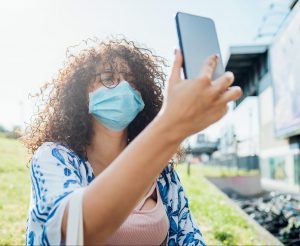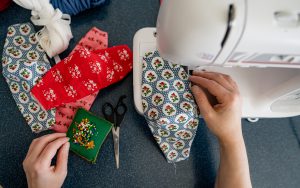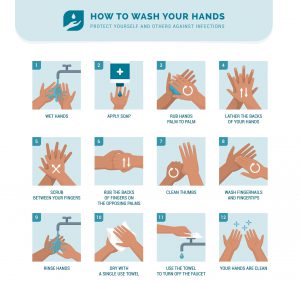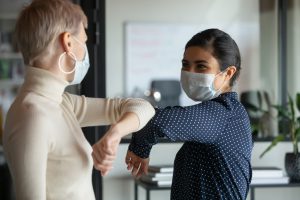How To Properly Wear A Face Mask
According to the CDC and other public health organizations, wearing a cloth face mask in public is intended to prevent the wearer from spreading COVID-19 in cases of non-symptomatic infections.
In other words, wearing a mask is about protecting others from infection. If everyone properly uses cloth face coverings in public, the risk of the virus spreading will be greatly reduced.

How to effectively wear your mask for the maximum protective effect.
As with any tool, masks only work if you use them correctly.

You might see a lot of people these days with their masks hanging down around their chin while they walk around in public. Some people wear masks that only cover their mouth. Others pull their masks down when talking.
All of these practices render mask-wearing useless.
To get the most effective protection from your mask, there are a few important guideline that you must follow.
- Always wear your mask the entire time you’re out in public. Continually donning and removing your mask can cause your hands to become contaminated which in turn could lead to you transmitting the virus when you touch surfaces.
- Make sure your mask covers your nose, mouth, and chin completely and that the edges make a tight seal to your face.
- Do not pull your mask down when you speak.
How and when to put on (and take off) your mask.
You’re wearing a mask to filter out viruses, which means it’s going to be covered in those viruses after wearing.
Putting your mask on and taking it off at the right time and in the right way is essential to protecting against the spread of COVID-19.
The CDC recommends the following procedures:
- Put your mask on before you go out in public and leave it on the whole time you’re out.
- Sanitize your hands after putting your mask on and after taking it off.
- Wash your mask frequently.
Wash reusable masks after every use. Discard single-use masks immediately after removing.
Many people now keep two or more masks so they can have one ready to wear while the other is going through the laundry.
Click here for more about washing your mask from Johns Hopkins Medicine.
What materials and types of masks are most effective?
 The most effective materials for filtering the coronavirus are those used in professional-grade N95 respirators. However, these are in short supply and officials are asking the public to leave them available for healthcare workers who are on the front lines of fighting the pandemic.
The most effective materials for filtering the coronavirus are those used in professional-grade N95 respirators. However, these are in short supply and officials are asking the public to leave them available for healthcare workers who are on the front lines of fighting the pandemic.
While N95 masks are the best option, similar results are possible with homemade masks if you use the right materials and follow some guidelines for construction.
Researchers suggest that one layer of tight-weave cotton combined with two layers of sheer silk, spandex, or chiffon can achieve results almost as good as an N95 respirator.
When making your homemade mask, also ensure that it meets the following requirements:
- The mask should cover the entire lower half of the face including your chin, mouth, and nose.
- Edges of the mask should press against the skin of your face.
- Loops or fasteners should be comfortable and secure so you don’t need to adjust your mask while wearing.
- The top edge of the mask should conform to the contours of the nose to create a tight seal.
There are plenty of resources on the web with instructions for making various styles of protective face masks. A great place to start is with this 10-minute video face-mask sewing tutorial on YouTube.

What about gloves?
While most people are not wearing gloves in public, there are some situations where it makes sense.
According to the Cleveland Clinic, SARS-COV-2 (the official name of the virus that causes COVID-19) can survive on surfaces for days. This means that keeping your hands clean and sanitized is an important factor in stopping the spread of the virus.
Frequent hand-washing is the single most important step in preventing surfaces from becoming contaminated. Using hand sanitizers can also help to kill the virus once it has gotten on your skin.
People who frequently touch potentially contaminated surfaces should wear gloves.
This infographic from the CDC shows how to use gloves to avoid contamination.
When will it be safe to go out without protective gear?
This may all seem like a lot of trouble, and many people are wondering how long we’ll have to keep up the daily practice of wearing masks, social distancing, and other methods for preventing the spread of the novel coronavirus.
While healthy individuals with access to care and good sanitation facilities may be safe, those in high-risk demographics and people who lack social and financial resources are particularly vulnerable.
 To protect vulnerable groups from infection, it is crucial that we all do our part by wearing masks and social distancing in public until such time as an effective vaccine is widely available.
To protect vulnerable groups from infection, it is crucial that we all do our part by wearing masks and social distancing in public until such time as an effective vaccine is widely available.
Unfortunately, there’s no way to predict how long it could be before a vaccine is available. Even when an effective vaccine becomes available, distribution to the entire population will still be a major challenge that could take months or years to overcome.
The bottom line? Masks and social distancing are likely to be the new normal, at least for the foreseeable future.



12 Comments. Leave new
Ohh, its fastidious discussion about this article here at this web site, I hace read all that, soo noww me also commenting at this place.
Feell free to surf to my webpage :: disinfection companies
viagra australia viagra onelaine genaric viagra [url=http://genqpviag.com/]free viagra samples canada[/url] ’
viagra in canada viagra gel uk buy viagra in spain [url=http://llviabest.com/]viagra dubai[/url] ’
free cialis canada order cialis in australia cialis 800mg black
canadian prescriptions online online drugstore cvs online pharmacy
Brand Viagra cialis super active humana online pharmacy
canadian pharmacy viagra canada prescriptions drugs canadian pharmaceuticals online reviews
drugs for sale therefore if traveling through europe you will need a separate visa to enter ireland. it is important to note, ordering viagra online cialis pharmacy online
generic viagra vs viagra viagra aus mastercard viagra vs. generic viagra
canadian pharmacy viagra generic buy viagra pharmacy 100mg canada drug prices
pharmacie prescription discount cheap prescription drugs online
viagra sell canada pharma limited llc pfizer viagra